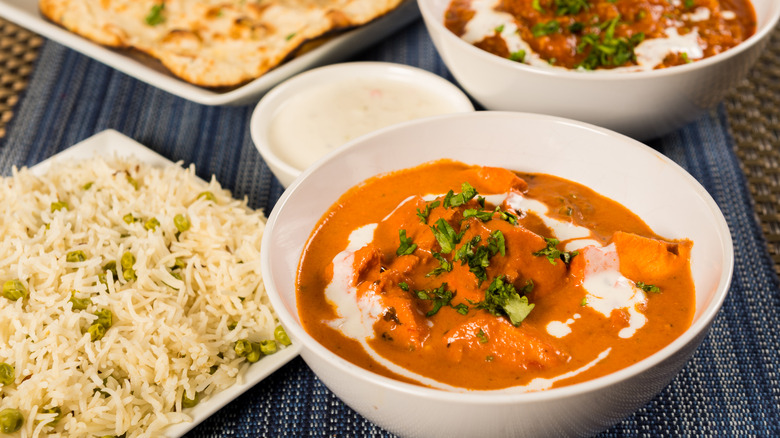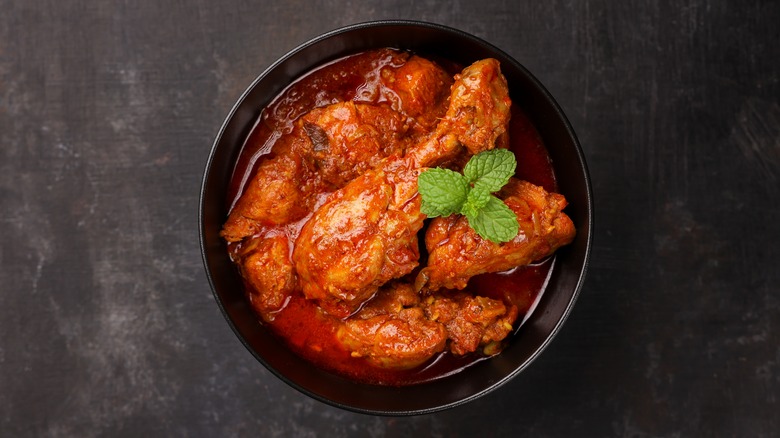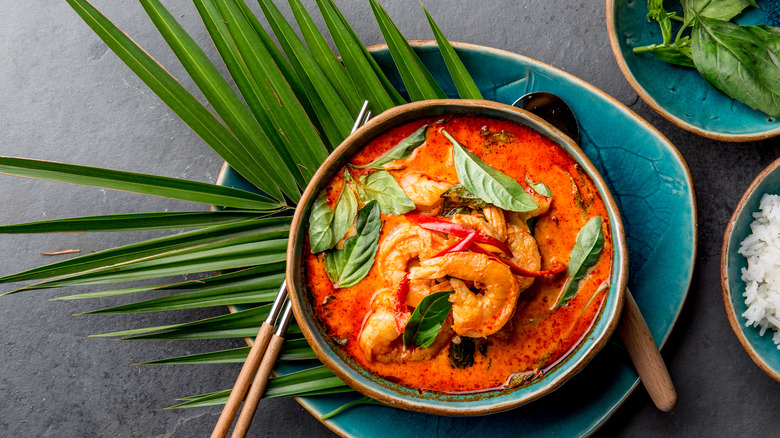How British Imperial Forces Created Today's Misunderstanding Of Curry
We may receive a commission on purchases made from links.
The case of curry is a peculiar one. As spaghetti bolognese is to Italy and California roll is to Japan, curry is a dish that is the flag bearer of Indian food across the world, but one that hardly exists in the very country that it is supposedly said to have come from. Curry is a blanket term used for any saucy, gravy-based dish and is believed to have originated in India. As long as the proteins and veggies aren't served dry, the dish can technically be passed off as curry on the menu of a restaurant. The rest of its ingredient list — including the spices — is ambiguous, which is perhaps why all those bowls of vindaloo, korma, and tikka masala may start to look and taste much the same after a few bites.
While dishes resembling curry do exist in parts of India, in reality, neither curry nor the all-in-one curry powder truly exists in the country in the form in which they are used across the rest of the world. In fact, even the word curry doesn't seem to exist in any official languages of India. So where did curry come from? Curry is believed to be a simplified version of kari, which exists in the southern parts of India, meaning spiced sauce in the Tamil language. The Portuguese who colonized Goa gave kari the name of caril (curee in plural), which was then transformed into the famous curry by the British Imperial forces along the way.
What is curry really?
According to Madhur Jaffrey, a pioneer of Indian food in Britain, curry is "a very confusing word because it means different things to different people" (via MasterClass). India is one of the largest and oldest countries in the world, which is why Indian food is drastically diverse even within its own borders. Many argue that an all-encompassing term like curry does Indian cuisine a great disservice. In reality, each curry goes by a specific name in India, each has a different preparation method, and each has a very distinct flavor from the other. Each "curry" is made using a different spice blend — usually freshly ground — and so neither has the blanket term curry used for any gravy-based dish ever existed in the Indian subcontinent nor has the pre-made curry powder that is used to make them.
In truth, the journey of curry began sometime in the 17th century when the first officers of the East India Company entered the Indian shores and got a taste of what the Portuguese were calling caril. Having developed a fondness for these dishes, the officers created an all-in-one spice blend that could recreate this diverse range of curries back home in Britain and all of its many colonies across the globe. Thus, the infamous curry powder was concocted, and with it a category of dishes known as curry, all cooked more or less from the same spice powder. These were seen more as quick-serve meals that could be cooked in big batches without the time-consuming methods that generally went into Indian cooking.
How curry spread across the world
The British imperial forces took the concept of curry back to Britain, and the country took to this spicy food very quickly. The first known curry recipe was published in Hannah Glasse's "The Art of Cookery" in 1747, which featured chicken in a cream, ginger, turmeric, and pepper sauce — and by 1810, Britain had its first Indian restaurant known as Hindoostane Coffee House. The British imperial forces were also the reason behind curry's popularity across the rest of the world. As indentured laborers from India made their way across British colonies in countries like Trinidad, Guyana, Sri Lanka, Jamaica, Mauritius, Malaysia, and Fiji, an anglicized version of curry evolved according to the region. In South Africa, for example, workers from southern parts of India created a dish known as bunny chow — a loaf of bread with its filling scooped out to make space for curry, meat, and vegetables — to smuggle food to South Africans of color who weren't allowed inside certain establishments during apartheid.
When Japan opened its borders to the rest of the world during the Meiji era, they too were introduced to a sweet, anglicized, and orangish-brown curry that was cooked for the British Navy. The Japanese Navy soon followed suit, especially when it was found that the flour used in curries was an antidote to beriberi, a vitamin B1 deficiency that took the Japanese Navy as an epidemic. Soon, curry turned into the very definition of Indian food across the globe except, the popular dish was more the invention of British imperial forces and their colonization than Indians.



